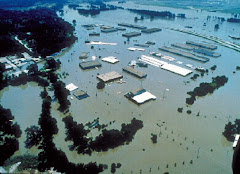Refrigerants Have High Global Warming Potential
The global warming potential of chemicals is well documented. This is usually documented by referencing how much a chemical will impact global warming as compared to a similar amount of carbon dioxide.
Refrigerants typically outrank carbon dioxide by a factor of 100 or even 1000 and stay in the atmosphere longer to our climate's detriment.
A global warming potential value is assigned to all greenhouse gases. This number is used by scientists to determine how gases, such as refrigerants, will impact global warming within 20 years, 100 years and 500 years.
Most greenhouses gases stay in the atmosphere longer than 20 years, with many as high as 100 years. Unless action is taken to control emissions and dangerous gases, considerable harm will be done to the earth and all living organisms on it.
In determining the global warming potential of a substance, three factors are considered. They are the amount of absorption of infrared radiation, the atmospheric location of where absorption takes place, and how long the substance remains in the atmosphere. A substance with a high potential has a greater impact of causing adverse climate change.
The lower the global warming potential of the substance the better for a healthy environment. All refrigerants in use today can contribute to global warming as greenhouse gases and this is why there are regulations in place to limit their use. These refrigerants will eventually be phased out and replaced with more palatable alternatives.
Chemicals with the highest global warming potential are hydrochlorofluorocarbons, such as those found in refrigeration and cooling systems. The values for hydrochlorofluorocarbons range from 120 to 12,240 over their atmospheric lifetime. When these numbers are broken down, it takes only one molecule of refrigerant gas to cause harm to the ozone layer.
The refrigerant R-113 Trichlorotrifluoroethane has one of the highest global warming potential values at 4800, while the refrigerant R-114 Dichlorotetrafluoroethane has one of the lowest values at 3.9. The alternative refrigerants being developed have no impact on global warming and are being used in the production of all types of new refrigeration and air conditioning systems.
Facilities that use refrigerants with a high global warming potential, for example commercial refrigeration and air-conditioning systems and HVAC systems, must monitor and track usage and submit reports regularly. Both the US Clean Air Act and other international treaties mandate these requirements.
emissions from refrigerants with a high global warming potential are on the decline due to new regulations, particularly those which refer to leak reporting and leak fixing. The United States has led the way and harmful refrigerant gases should be phased out by 2015. Facilities must comply with the appropriate regulations to avoid penalty, but more importantly help to sustain the future of the world's environment.
Article Directory: http://www.articledashboard.com
Subscribe to:
Post Comments (Atom)



1 comment:
Nice guide thank you!/ I love it! very creative! That's actually really cool Thanks.
Commercial Refrigeration
Post a Comment